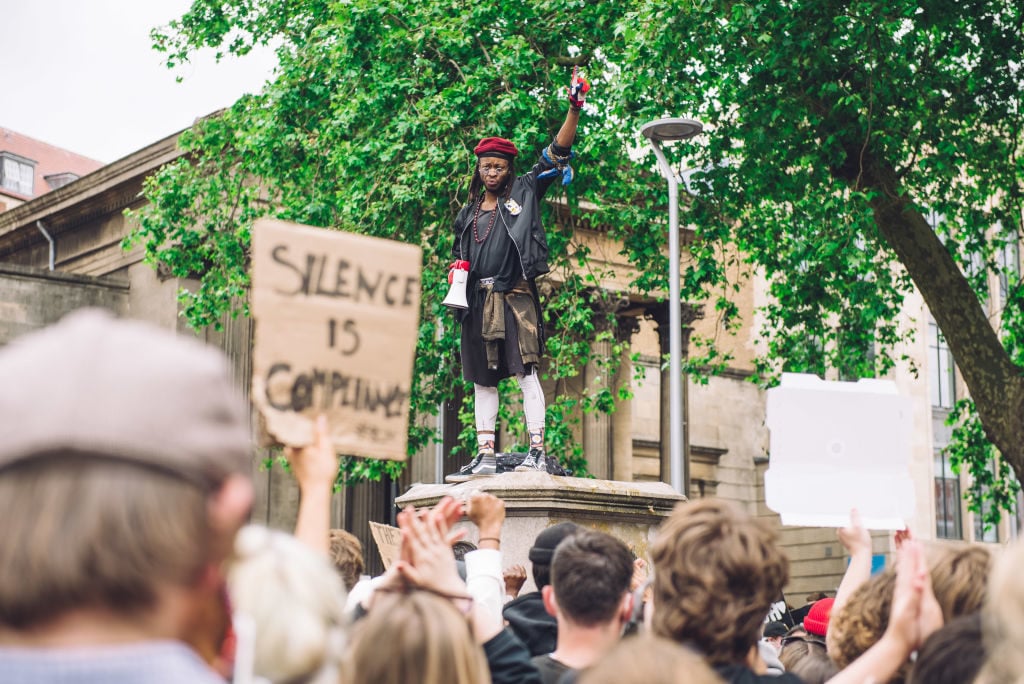Law & Politics
The UK Government Plans to Make It Harder to Remove Public Monuments to Controversial Figures
One minister referred to demonstrators as "baying mobs."

One minister referred to demonstrators as "baying mobs."

Naomi Rea

The UK government could make it more difficult for local authorities to take down public monuments to controversial historical figures.
A UK minister announced the decision to introduce new legislation surrounding monuments in an op-ed in the Telegraph on Sunday, in which he argued that public monuments should not be removed at the behest of a “baying mob.”
The secretary of state for communities, Robert Jenrick, wrote that the UK’s monuments are a valuable part of its history, and that the recent swell of protests surrounding certain monuments seek to “erase” that history.
Jenrick argued that “due process” should be respected before monuments are removed, and said he would be changing the law to protect historic monuments, with decisions to remove them to require planning permission and consultation with the local community but also federal government approval. If passed into law, it means that the go-ahead to remove a statue will need to be granted by the sitting secretary of communities. This law would apply to 20,000 statues across England.
Jenrick is expected to propose this new legislation in Parliament later today, and will outline the official government stance, to be set out in law, that “monuments are almost always best explained and contextualized, not taken and hidden away.” Proposals for new legislation are debated and voted on in Parliament before being passed on to the House of Lords for a second vote after which they are ratified as law.
“It is our duty to preserve our culture and heritage for future generations and these new laws will help to do so,” the culture secretary Oliver Dowden says in a statement.
The move comes following Black Lives Matter demonstrations last summer, during which protests centered around monuments to racist historical figures resulted in the high profile toppling of a statue of a slaver in Bristol, among other monuments around the country.
The protests led to the prime minister Boris Johnson penning his own staunch defense of a monument to his personal idol, Winston Churchill, and culture secretary Dowden writing a letter of warning to publicly funded institutions outlining that “the government does not support the removal of statues or other similar objects.”
The felled statue of slaver Edward Colston is now in Bristol’s museums collection, and four activists are facing criminal damage charges for their role in its removal. Some commentators responding to Jenrick’s article, which emphasized that monuments were often erected on a local level and reflected “the people’s preferences at the time,” have pointed to the Colston statue as a case study. It was erected 170 years after the 17th century slaver’s death, and the local community refused to pay for it at the time. Organizations in Bristol had also long been campaigning against the statue, and discussions about officially installing a contextualizing plaque dissolved in 2019 after officials disagreed about its wording.
The debate surrounding what figures are celebrated in the UK’s public spaces has continued since last summer, and there have been growing campaigns to create new monuments celebrating the contributions of Black, Asian, and ethnic minority figures to British history. The artist Yinka Shonibare is working on a sculpture for Leeds commemorating a Nigerian immigrant whose death sparked a reckoning with UK police. Meanwhile, the mayor of London has set up a commission for diversity in the public realm, which will review the diversity of its monuments and street names.